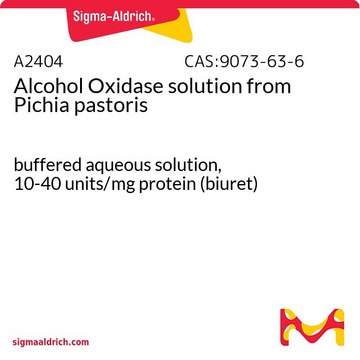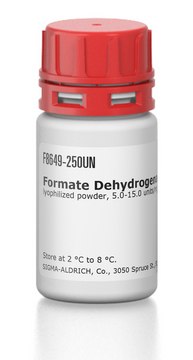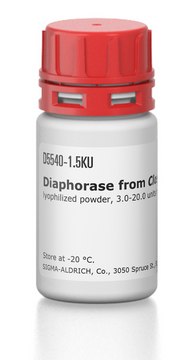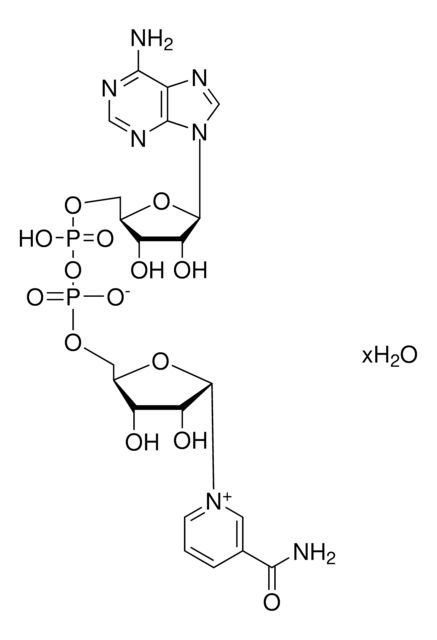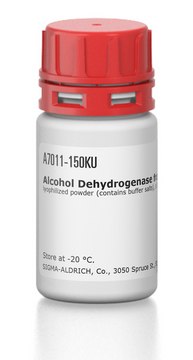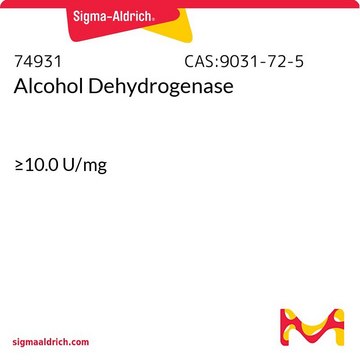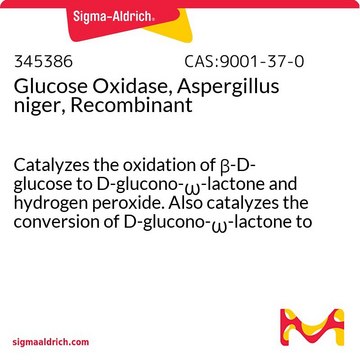F1879
Formaldehyde Dehydrogenase from Pseudomonas sp.
lyophilized powder, 1.0-6.0 units/mg solid
Synonym(s):
FDH, Formaldehyde:NAD+ oxidoreductase
Sign Into View Organizational & Contract Pricing
All Photos(3)
About This Item
CAS Number:
MDL number:
UNSPSC Code:
12352204
Recommended Products
form
lyophilized powder
specific activity
1.0-6.0 units/mg solid
storage temp.
−20°C
Looking for similar products? Visit Product Comparison Guide
General description
Formaldehyde Dehydrogenase (FDH) belongs to the medium-chain alcohol dehydrogenase family. It is encoded by the fdhA and fdhB gene in Pseudomonas aeruginosa. The FDH sequences of P. aeruginosa and P. putida are conserved and show homology. FDH exists as dimer and tetramer with zinc in their catalytic active site. The monomer corresponds to 350-400 amino-acid residues.
Application
Formaldehyde Dehydrogenase from Pseudomonas sp. has been used:
- For standard curve generation for the demethylation-FDH assay of lysine specific demethylase 1 (LSD1) and in formaldehyde dehydrogenase (FDH) assay.
- As a biosensor for the presence of formaldehyde in pharmaceuticals, waste water, vaccines and industrial products.
- In coupled pectin methyl esterase (PME) enzyme assay.
Biochem/physiol Actions
Formaldehyde dehydrogenase (FDH) is an enzyme that catalyzes the oxidation of formaldehyde to formate with NAD+ as an electron acceptor.Formaldehyde dehydrogenases are involved in the biological detoxification of formaldehyde, a toxic product in the metabolism of compounds like histidine, vanillate etc. They detoxify by converting formaldehyde to carbon-di-oxide. FDH plays a crucial role in regulating protein S-nitrosation in mammalian cells by decomposing S-nitrosoglutathione. They are also involved in the regulation of nitrosothiol homeostasis by catalyzing the reduction of endogenous nitrosylating agent S-nitrosoglutathione (GSNO).
Unit Definition
One unit will oxidize 1.0 μmole of formaldehyde to formic acid per min at pH 7.5 at 37 °C.
Physical form
Lyophilized powder containing ~70% stabilizers as Mg2+, Ca2+, bovine serum albumin, glycine, and lysine
Storage Class Code
11 - Combustible Solids
WGK
WGK 3
Flash Point(F)
Not applicable
Flash Point(C)
Not applicable
Personal Protective Equipment
dust mask type N95 (US), Eyeshields, Gloves
Regulatory Information
常规特殊物品
含少量动物源组分生物产品
Choose from one of the most recent versions:
Already Own This Product?
Find documentation for the products that you have recently purchased in the Document Library.
Expression, purification, and characterization of formaldehyde dehydrogenase from Pseudomonas aeruginosa
Zhang W, et al.
Protein Expression and Purification, 92(2), 208-213 (2013)
In Vitro Enzyme Assays for JmjC-Domain-Containing Lysine Histone Demethylases (JmjC-KDMs)
Tarhonskaya H, et al.
Current protocols in pharmacology, 80(1), 3-15 (2018)
Slobodanka Grsic-Rausch et al.
Analytical biochemistry, 333(1), 14-18 (2004-09-08)
Pectin methylesterase (PME; EC 3.1.1.11) activities are widespread in bacteria, fungi, and plants. PME-mediated changes in cell wall pectin structure play important roles in plant development. Genome sequencing projects have revealed the existence of large PME multigene families in higher
Structure of formaldehyde dehydrogenase from Pseudomonas aeruginosa: the binary complex with the cofactor NAD+
Liao Y, et al.
Acta Crystallographica Section F, Structural Biology and Crystallization Communications, 69(Pt 9), 967-972 (2013)
Redundancy of enzymes for formaldehyde detoxification in Pseudomonas putida
Roca A, et al.
Journal of Bacteriology, 191(10), 3367-3374 (2009)
Our team of scientists has experience in all areas of research including Life Science, Material Science, Chemical Synthesis, Chromatography, Analytical and many others.
Contact Technical Service